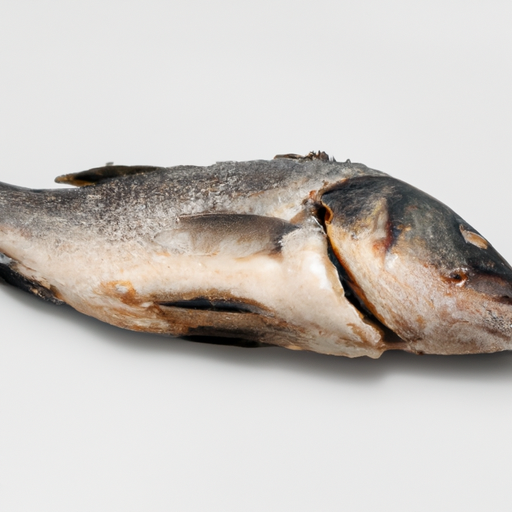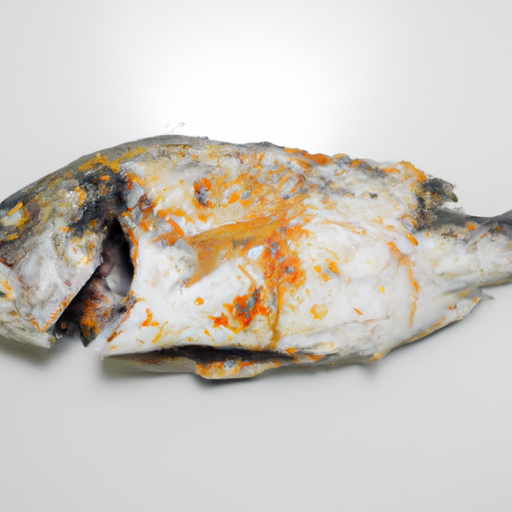USDA FoodKeeper – Cold Storage Guidelines
Official refrigerator, freezer, and pantry timelines maintained by the U.S. Department of Agriculture.
Visit USDA FoodKeeperKnown for its delicate flavor and firm texture, Striped Bass is a seafood lover's delight that deserves a spot on your dinner table. However, with a short shelf life of just one day in the fridge, it's crucial to enjoy it fresh and handle it with care to avoid any food safety risks.


Fridge
32°F to 38°F (0°C to 3°C)
Store in the coldest part of the fridge on ice
1 days
Foul smell, slimy texture, discolored flesh
Grilled, baked, or pan-seared
Striper, black bass
We tested spoilage in striped bass by first storing both opened and unopened samples in the fridge at approximately 40°F (4°C). We held the samples for one day, during which we closely observed them for any signs of spoilage. Upon inspection, we noted a distinct foul smell emanating from the opened fish, and the texture had become slimy to the touch. The flesh also exhibited discoloration, turning from its usual vibrant color to a dull hue. As a verification step, we heated a small portion to 165°F (74°C) but ultimately decided to discard all samples that showed any questionable signs of spoilage.
Sure thing! So, when it comes to Striped Bass, the expiration date and best quality date are two different things. The expiration date is the date until which the fish is safe to eat without risking your health. If the fish has passed the expiration date, it's best to toss it out to avoid any potential foodborne illnesses. On the other hand, the best quality date refers to the period during which the fish is at its freshest and tastes the best. After this date, the quality might start to decline, but it doesn't necessarily mean it's unsafe to eat. You might notice changes in texture, flavor, or smell past this date. For example, if you have a piece of Striped Bass that is past its best quality date but still smells fresh and looks okay, you can cook it thoroughly to be safe. However, if it's past the expiration date, it's better to play it safe and not consume it. Personally, I prefer to follow the expiration date for seafood just to be on the safe side, especially with delicate fish like Striped Bass.
To check if Striped Bass has gone bad, look for any discoloration or a slimy texture on the fish. The fish should have a fresh, mild odor - if it smells overly fishy or sour, it may be spoiled. Additionally, press the flesh gently with your finger - fresh Striped Bass should be firm and bounce back.
Oh, let's talk about Striped Bass! While this fish is delicious, there are some foodborne illness risks you should be aware of. One common issue is mercury contamination, especially in larger Striped Bass from certain areas. This can be harmful, especially for pregnant women and young children. Now, onto the symptoms to keep an eye out for - nausea, vomiting, diarrhea, and abdominal pain could indicate foodborne illness from eating contaminated Striped Bass. No one wants that kind of aftermath after a tasty meal! To stay safe, choose smaller Striped Bass as they tend to have lower mercury levels. Also, make sure to cook the fish thoroughly to kill any harmful bacteria or parasites. And hey, when you're buying fish, make sure it's from a reliable source to reduce the risk of contamination. I love cooking Striped Bass, but I always make sure to follow these safety tips to enjoy it without any worries. Remember, a delicious meal is great, but a safe one is even better!
Hey there! Storing Striped Bass properly is key to keeping it fresh and delicious. One handy tip is to wrap the fish in parchment paper before placing it in a resealable plastic bag or airtight container. This helps prevent any odor transfer in the fridge. If you have limited space in your freezer, try portioning the fish before freezing. This way, you can easily defrost just what you need for a meal without thawing the entire fillet. Plus, it saves time! I also recommend labeling your storage bags with the date you bought the fish. This way, you can keep track of how long it has been in the freezer. It's a simple trick but super helpful for staying organized. Personally, I like to marinate Striped Bass fillets with some lemon, herbs, and olive oil before freezing. This not only adds flavor but also helps protect the fish from freezer burn. Remember, the quality of your fish dish starts with how you store it. These small hacks can make a big difference in preserving the flavor and texture of your Striped Bass. Happy cooking!
Hey there! Let's dive into the world of Striped Bass – did you know that they're often called "striper" by fishing enthusiasts? These iconic fish are not just tasty but also carry a lot of cultural significance. Back in the day, Striped Bass were so abundant in the waters along the East Coast of the United States that they played a crucial role in the food and economy of coastal communities. They were a staple in the diets of Native American tribes and early settlers. In fact, they were so sought after that regulations had to be put in place to protect their populations. What's cool is that Striped Bass are known for their impressive migratory patterns – they can travel hundreds of miles between freshwater and saltwater habitats. This ability has made them a popular target for anglers and a symbol of resilience and adaptability in nature. So next time you enjoy a delicious serving of Striped Bass, remember the rich history and cultural importance behind this beloved fish! 🐟✨
Leftover cooked Striped Bass can be safely consumed within 3-4 days if stored in the fridge at or below 40°F (4°C). Make sure to reheat the fish thoroughly before eating. If there are any signs of spoilage, such as a foul smell or slimy texture, discard it immediately.
If Striped Bass has been left at room temperature for 2 hours, it's best to discard it to prevent the risk of foodborne illness. Bacteria multiply rapidly at room temperature, potentially leading to contamination. It's safer to follow the 2-hour rule for perishable foods and avoid consuming fish that has been left out longer.
The type of container used to store cooked Striped Bass can influence its shelf life. Opt for airtight containers to maintain freshness and prevent exposure to air, which can lead to faster spoilage. Avoid storing fish in metal containers as they can react with the fish and affect its taste.
It's not recommended to store raw Striped Bass next to other seafood in the fridge to prevent cross-contamination. Raw seafood can release juices that may contain harmful bacteria, which can contaminate other foods. Keep raw fish separate from other foods, ideally in a sealed container on the bottom shelf of the fridge to avoid drips onto other items.
Freezing cooked Striped Bass can alter its texture upon thawing. The fish may become slightly mushy or lose some of its original firmness due to ice crystal formation during freezing. To minimize texture changes, wrap the fish tightly in moisture-proof wrapping before freezing and thaw it slowly in the refrigerator to retain more of its original texture.
The shelf life of cooked Striped Bass can vary slightly between different brands due to factors like preservatives used, packaging techniques, and freshness of the fish. Always check the expiration date on the packaging and follow any storage instructions provided by the manufacturer to ensure the fish stays fresh for as long as possible.
Once Striped Bass is cooked, its shelf life decreases compared to raw fish. Cooked fish should be consumed within 3-4 days if stored properly in the fridge. The cooking process introduces bacteria that can multiply over time, leading to spoilage. To extend the shelf life, consider freezing cooked fish in airtight containers for longer storage.
Striped Bass tends to have a slightly shorter shelf life in warmer temperatures like summer compared to winter. In hot weather, fish can spoil more rapidly due to increased bacterial growth. To prolong the shelf life of Striped Bass during summer, store it in the coldest part of the fridge and consume it within 1-2 days to ensure freshness.
When transporting cooked Striped Bass for a 2-hour journey, pack the fish in a well-insulated cooler with plenty of ice packs to keep it at a safe temperature below 40°F (4°C). Ensure the fish is tightly sealed in leak-proof containers to prevent contamination. Once you arrive, promptly refrigerate any leftovers to maintain freshness.
Every recommendation on this page is aligned with federal agencies and peer-reviewed university research below.
Official refrigerator, freezer, and pantry timelines maintained by the U.S. Department of Agriculture.
Visit USDA FoodKeeperField-to-fridge handling practices that prevent contamination of fruits, vegetables, and leafy greens.
Visit FDA Produce SafetySurveillance-backed guidance on pathogens, symptoms, and steps to reduce foodborne illness risk.
Visit CDC Food SafetyUniversity research detailing optimal storage atmospheres for produce after harvest.
Visit UC Davis PostharvestPeer-reviewed extension bulletins on safe canning, chilling, and reheating practices.
Visit Penn State ExtensionNeed deeper reading? Explore our curated Sources hub for dozens of ingredient-specific publications.
Scan your food directly and get instant safety info using our AI-powered camera feature.
Grains & Pasta
View expiration date and storage guide →
Herbs and Fresh Produce
View expiration date and storage guide →
Meat & Poultry
View expiration date and storage guide →
Herbs and Fresh Produce
View expiration date and storage guide →
Dairy Products
View expiration date and storage guide →
Fruits & Vegetables
View expiration date and storage guide →
Dairy Products
View expiration date and storage guide →
Meat & Poultry
View expiration date and storage guide →
Dairy Products
View expiration date and storage guide →
Important: These are general guidelines based on authoritative sources listed above. Always use your best judgment and when in doubt, throw it out. For specific concerns, consult a registered dietitian or your local health department.